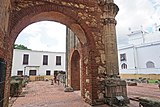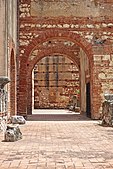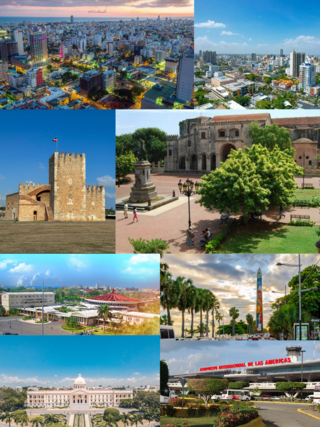
Santo Domingo, once known as Santo Domingo de Guzmán, known as Ciudad Trujillo between 1936 and 1961, is the capital and largest city of the Dominican Republic and the largest metropolitan area in the Caribbean by population. As of 2022, the city and immediate surrounding area had a population of 1,029,110 while the total population is 3,798,699 when including Greater Santo Domingo. The city is coterminous with the boundaries of the Distrito Nacional, itself bordered on three sides by Santo Domingo Province.

Old San Juan is a historic district located at the "northwest triangle" of the islet of San Juan in San Juan. Its area roughly correlates to the Ballajá, Catedral, Marina, Mercado, San Cristóbal, and San Francisco sub-barrios (sub-districts) of barrio San Juan Antiguo in the municipality of San Juan, Puerto Rico. Old San Juan is the oldest settlement within Puerto Rico and the historic colonial district of the city of San Juan. This historic district is a National Historic Landmark District named Zona Histórica de San Juan and is listed on the United States National Register of Historic Places as the Old San Juan Historic District. Several historical buildings and structures, particularly La Fortaleza, the city walls, and El Morro and San Cristóbal castles, have been inscribed in the UNESCO World Heritage Site list since 1983. Historically the mixed-use commercial and residential real estate in the main streets of Calle Cristo and Calle Fortaleza from Calle Tanca to the Governor’s Mansion is the most valuable in the area and it has kept its value and increased steadily through several years despite the past economic turmoils.

Intramuros is the 0.67-square-kilometer (0.26 sq mi) historic walled area within the city of Manila, the capital of the Philippines. It is administered by the Intramuros Administration with the help of the city government of Manila.

Ciudad Colonial is the historic central neighborhood of the Dominican Republic's capital Santo Domingo. It is the oldest continuously inhabited European-established settlement in the Americas. The area has been declared a World Heritage Site by UNESCO. It is also known as Zona Colonial or more colloquially as "La Zona".
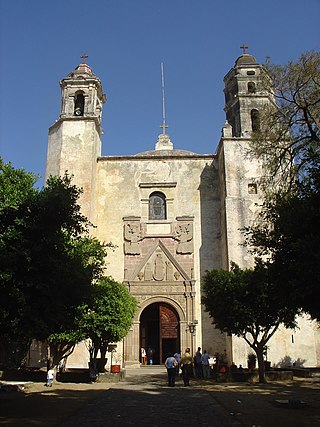
The Earliest Monasteries on the Slopes of Popocatepetl are sixteen earliest 16th-century monasteries which were built by the Augustinians, the Franciscans and the Dominicans in order to evangelize the areas south and east of the Popocatépetl volcano in central Mexico. These monasteries were recognized by the UNESCO as World Heritage Sites in 1994, because they served as the model for the early monastery and church buildings as well as evangelization efforts in New Spain and some points beyond in Latin America. These monasteries almost uniformly feature a very large atrium in front of a single nave church with a capilla abierta or open chapel. The atrium functioned as the meeting point between the indigenous peoples and the missionary friars, with mass for the newly converted held outdoors instead of within the church. This arrangement can be found repeated in other areas of Mexico as these friars continued to branch out over New Spain.
Villa Mella, or San Felipe de Villa Mella, is a municipality in Santo Domingo Norte, Dominican Republic. Villa Mella is located north of the Isabela River, about 6 miles to the north of the center of Santo Domingo, and is considered an additional neighborhood of the capital. This sector is considered one of the economically stable areas in the Santo Domingo metropolitan area. It is also home to the musical organization known as the Brotherhood of the Holy Spirit of the Congos of Villa Mella, recognized in 2001 by UNESCO.

The Ozama Fortress, also formerly known as the city wall's Homage tower, is one of the surviving sections of the Walls of Santo Domingo, which is recognized by UNESCO as being the oldest military construction of European origin in the Americas. It was built between 1502-1508 by the Spanish at the entrance to Santo Domingo's Ciudad Colonial, Dominican Republic, and overlooking the Ozama River. Named after this river, the castle, also referred to as "La Fortaleza" or "The Fortress". It was declared by UNESCO as a World Heritage Site, together with the other historical monuments of the Ciudad Colonial.

The Alcázar de Colón, or Columbus Alcazar is the first fortified European palace built in the Americas. It is located in the Dominican Republic's colonial area of Santo Domingo city, and forms part of the Ciudad Colonial UNESCO's World Heritage Site. It was built between 1510 and 1514 mostly in a Gothic and Renaissance style.

Monasterio de San Francisco in Santo Domingo de Guzmán, Dominican Republic, is a monastery that was built between 1508–1560, with the arrival of the Franciscan fathers. The ruin is one of the most important of the city. It is located in the Colonial City of Santo Domingo and are part of UNESCO's 1990 declaration of the Colonial City as a World Heritage Site. The monastery was recognized by UNESCO for being the first and oldest monastery built in the Americas.

The Cathedral of Santa María la Menor in the Colonial City of Santo Domingo is dedicated to St. Mary of the Incarnation. It is the first and oldest cathedral in the Americas, begun in 1504 and was completed in 1550. It is the cathedral of the Archbishop of Santo Domingo who has the honorary title of Primate of the Indies because this cathedral was the first diocese and the oldest cathedral established in the New World.

The Museo de las Casas Reales is one of the important cultural monuments built during the colonial era in Hispaniola, now the Dominican Republic. It is located in the Colonial district of Santo Domingo.

The Military Bishopric of the Dominican Republic is a military ordinariate (quasi-diocese) of the Roman Catholic Church.

La Puerta del Conde was the main entrance to the fortified city of Santo Domingo, named to honor Governor Captain-General Bernardino de Meneses Bracamonte y Zapata, 1st Count of Peñalva, who during his tenure saved the city from a siege in 1655 by Englishmen General Robert Venables and Admiral William Penn amid the Third Anglo-Spanish War.

Parque Colon, or Columbus Park, is the central square of the Ciudad Colonial historic district of Santo Domingo, Dominican Republic. In its center stands a statue of Christopher Columbus, in whose honor the square was renamed in 1887. Previously the square was known as Plaza Mayor.
The following is a timeline of the history of the city of Santo Domingo in the Dominican Republic.
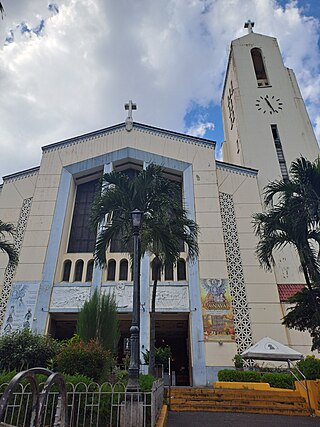
Santo Domingo Church, formally known as the National Shrine of Our Lady of the Holy Rosary of La Naval de Manila, is a Roman Catholic national shrine and parish church in Quezon City, Metro Manila in the Philippines. Dedicated to Mary, mother of Jesus under her title Our Lady of the Most Holy Rosary — La Naval de Manila, it was founded by the Dominicans in 1587.

Mixcoac is an area of southern Mexico City which used to be a separate town and municipality within the Mexican Federal District until it was made part of Mexico City proper in 1928.

Tourism in the Dominican Republic is an important sector of the country's economy. More than 10 million tourists visited the Dominican Republic in 2023, making it the most popular tourist destination in the Caribbean and putting it in the top 5 overall in the Americas. The industry accounts for 11.6% of the nation's GDP and is a particularly important source of revenue in coastal areas of the country. The nation's tropical climate, white sand beaches, diverse mountainous landscape and colonial history attracts visitors from around the world. In 2022, the nation's tourism was named the best-performing nation post-pandemic with over 5% visitors more in comparison to pre-pandemic levels in 2019.







